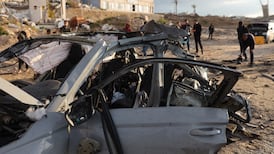Syria's director of antiquities Maamoun Abdulkarim is a happy, excited man. He asks me to step around the corner of his desk in his office in the National Museum to show me aerial photos taken by a drone of the Bel Temple, in the ancient city of Palmyra, which was destroyed by Islamic State last summer. "You see, you see, all the stones are there, we can rebuild."
He switches to the Baal Shamim temple, blown up too by Islamic State (Isis), also known as Daesh. "Here too, we can rebuild," he says. He feels at long last all the knowledge he has acquired during his years as an archaeologist can be put to work.
"I am so happy you came to see me after your visit to Palmyra," he says, a day after The Irish Times visited the ancient city. He has not yet gone there since its recapture from Islamic State last month by Syrian government forces. His face has been seen too often on television so he has had to have security clearance.
The road to Palmyra from Damascus is still not quite safe. Islamic State elements lurk in the desert. He has had to rely on reports from colleagues and images captured by a drone.
Authenticity protocol
“We can reconstruct the two temples and the [also destroyed] Triumphal Arch from materials in place on the sites,” he says, speaking quickly, his voice expressing eagerness to get down to work. “We are preparing a plan to reconstruct. We have photos of the state of the buildings before Daesh and after Daesh.
“We will respect the authenticity of the buildings and not add foreign material to the facade . . . we have the expertise. The foundations of the Bel Temple and Baal Shamim are solid, the stones are not broken. We can quarry stone from Palmyra if we need to.” The same is true of the Triumphal Arch, he says.
He has architectural drawings and other material on the two temples prepared by French archaeologists Robert Ami in the 1930s and Paul Collar from 1953-1956. "We have a team of 30 people – architects, archaeologists and engineers. In 2014 we restored the [Crusader castle] Krak des Chevaliers. We have the experience to work if we are under peace."
His department is preparing plans for Unesco and its partners, and consulting international experts with a view to raising funds.
“I can give you a promise that we can finish the maximum of the work within five years,” he says. “The monuments will not be the same as before Daesh [destroyed them]. I hope the international community understands that the restoration of Palmyra is for the whole world . . . and the issue will not be politicised.”
He fears the current international embargoes and sanctions on Syria could hinder the work. "Palmyra is our common heritage," he states.
Abdulkarim has some good news regarding Palmyra. Although Islamic State destroyed the tower tombs on the edge of the site of the ancient city, the chamber of the Tomb of the Three Brothers, with its beautiful wall paintings, has not been destroyed. “Daesh used it for an office,” he says.
“We have to accept the reality of the situation. All has not been destroyed. Eighty per cent of the site has not been damaged. Our children can visit in future. We also rescued 90 per cent of the items from the [Palmyra] Museum: 400 busts, pottery, glassware, exceptional vases and coins.”
Abdulkarim says he went with his family to visit the wife of Khaled al-Asaad, Palmyra’s curator who was beheaded by Islamic State, and received permission to make his flat in the museum into a memorial to him. The square [where Asaad’s body was displayed] will be named Khaled al-Asaad Square.”
Triumphal Arch
He has been invited to attend the April 19th inauguration in London of the replica of the Triumphal Arch made by 3D printers. “It has a beautiful feeling. We began to prepare it three months before the liberation,” he says. It will be displayed in
Trafalgar Square
in London,
Times Square
in
New York City
, in European cities, and Damascus.” Once the tour ends, “it will be placed in the main square of Palmyra.” He holds up a small statue of a lion copied from a piece in the National Museum. “See this was done by 3D printer in Paris. They made two for me. Next time you come, I will give one to you.”












